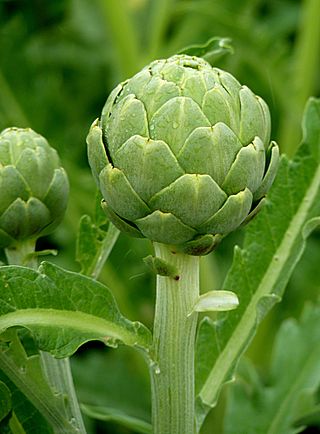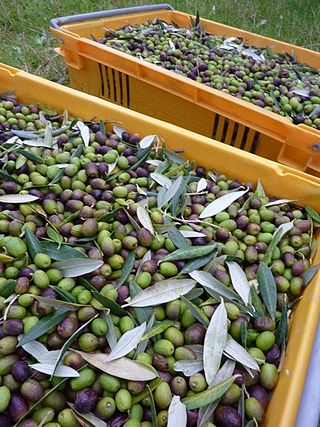| Hojiblanca | |
|---|---|
 Olive Hojiblanca, Castelltallat, Spain | |
| Olive (Olea europaea) | |
| Origin | Spain |
| Use | Table and oil |
Hojiblanca (literally translated, "white leaf" in Spanish) is an olive cultivar from Lucena (Spain).
| Hojiblanca | |
|---|---|
 Olive Hojiblanca, Castelltallat, Spain | |
| Olive (Olea europaea) | |
| Origin | Spain |
| Use | Table and oil |
Hojiblanca (literally translated, "white leaf" in Spanish) is an olive cultivar from Lucena (Spain).
Azufaijada, Barquillero, Casta de Cabra, Casta de Lucena, Foglia Bianca, Hojiblanca de Fruto Grueso, Hojiblanca de Lucena, Lucentino, Nevadillo Blanco de Osuna, Ojiblanca, Picudo, Zorzariega, Hojiblanca de Aracena. [1]
Hojiblanca, one of 262 Spanish varieties, is a large fruit, up to 4.8 grams (0.17 oz), spherical in shape, a flesh to stone is 8:1, and an oil yield of 17-19%. The cultivar is endemic to Priego de Córdoba. Flavors attributed to the variety: Slightly sweet to start with a bitter taste of unripe fruits and an almond aftertaste. [2]
It represents 16% of the olive production in Andalucia and is grown mainly in the Spanish provinces of eastern Seville, southern Cordoba and northern Málaga. In Andalucia it is collected in late autumn (November–December) as green or black ripe olives for eating, or late in the season (March–April) to produce oil. [3] These olives are popular table olives, [3] and are also used to produce oil, though the oil content is lower than some popular Spanish olive cultivars like the Picual. [4]

Andalusia is the southernmost autonomous community in Peninsular Spain. Andalusia is located in the south of the Iberian Peninsula, in southwestern Europe. It is the most populous and the second-largest autonomous community in the country. It is officially recognised as a historical nationality and a national reality. The territory is divided into eight provinces: Almería, Cádiz, Córdoba, Granada, Huelva, Jaén, Málaga, and Seville. Its capital city is Seville. The seat of the High Court of Justice of Andalusia is located in the city of Granada.

Olive oil is a liquid fat obtained by pressing whole olives, the fruit of Olea europaea, a traditional tree crop of the Mediterranean Basin, and extracting the oil.

The olive, botanical name Olea europaea, meaning 'European olive', is a species of small tree or shrub in the family Oleaceae, found traditionally in the Mediterranean Basin, with wild subspecies found further afield in Africa and western Asia. When in shrub form, it is known as Olea europaea'Montra', dwarf olive, or little olive. The species is cultivated in all the countries of the Mediterranean, as well as in Australia, New Zealand, North and South America and South Africa. It is the type species for its genus, Olea. The tree and its fruit give their name to the Oleaceae plant family, which also includes species such as lilac, jasmine, forsythia, and the true ash tree.

The avocado, alligator pear or avocado pear is a medium-sized, evergreen tree in the laurel family (Lauraceae). It is native to the Americas and was first domesticated in Mesoamerica more than 5,000 years ago. It was prized for its large and unusually oily fruit. The tree likely originated in the highlands bridging south-central Mexico and Guatemala. Avocado trees have a native growth range from Mexico to Costa Rica. Its fruit, sometimes also referred to as an alligator pear or avocado pear, is botanically a large berry containing a single large seed. Sequencing of its genome showed that the evolution of avocados was shaped by polyploidy events and that commercial varieties have an hybrid origin. Avocado trees are partly self-pollinating, and are often propagated through grafting to maintain consistent fruit output. Avocados are presently cultivated in the tropical and Mediterranean climates of many countries. Mexico is the world's leading producer of avocados as of 2020, supplying nearly 30% of the global harvest in that year.

The globe artichoke, also known by the names French artichoke and green artichoke in the United States, is a variety of a species of thistle cultivated as food.

Lucena is a municipality of Spain belonging to the province of Córdoba, in the autonomous community of Andalusia.

Arbequina is a cultivar of olives. The fruit is highly aromatic, small, symmetrical and dark brown, with a rounded apex and a broad peduncular cavity. In Europe, it is mostly grown in Catalonia, Spain, but is also grown in Aragon and Andalusia, as well as California, Argentina, Chile, Australia and Azerbaijan. It has recently become one of the dominant olive cultivars in the world, largely under highly intensive, "super high-density" plantation.
Empeltre is a type of medium-sized, black olive originating in Spain. It is used both as a table olive and to produce a high-quality olive oil.
Andalusian cuisine is the regional cuisine of Andalusia, Spain. Notable dishes include gazpacho, fried fish, the jamones of Jabugo, Valle de los Pedroches and Trevélez, and the wines of Jerez, particularly sherry. Culinary influences come from the historic Christian, Muslim, and Jewish traditions of the region. The oldest known cookbook of Andalusian cuisine, Kitab al tabij fi-l-Maghrib wa-l-Andalus fi `asr al-Muwahhidin, li-mu'allif mayhul, dates from the 13th century.

Estepa is a municipality in the extreme south-east of the province of Seville. It had a population of 12.631 in 2013. The town is located north of the Sierra del Becerro mountains.

The Kalamata olive is a large, dark purple olive with a smooth, meaty texture, named after the city of Kalamata in the southern Peloponnese, Greece. Often used as table olives, they are usually preserved in wine vinegar or olive oil. Typically the term "Kalamata" legally refers to a region of Greece where these olives are grown, but a few countries use the name for such olives grown anywhere, even outside of Greece. Within the EU, the name is protected with PDO status, which means that the name can only be used for olives from the region around Kalamata. Olives of the same variety grown elsewhere are marketed as Kalamon olives in the EU and, sometimes, elsewhere.

A pumpkin is a cultivated winter squash in the genus Cucurbita. The term is most commonly applied to round, orange-colored squash varieties, though it does not possess a scientific definition and may be used in reference to many different squashes of varied appearance.

Padrón pepper, also called Herbón pepper, is a landrace variety of pepper from the municipality of Padrón in northwestern Spain.

The Leccino olive is one of the primary olive cultivars used in the production of Italian olive oil. Across Italy, it is one of the primary olive cultivars found in olive groves. It is believed to have originated in Tuscany, and it is now grown all over the world. Due to its delicate flavor, the olive oil it produces is commonly blended with Frantoio, Coratina, Moraiolo and Pendolino in order to create more flavor.
The Mission olive is a cultivar of olive developed in California, by Spanish missions along El Camino Real in the late 18th century. The Mission olive has been included in the Ark of Taste, an international catalog of endangered heritage foods maintained by the Slow Food movement. It is also the only American olive cultivar listed by the International Olive Council in its World Catalogue of Olive Varieties. Although developed in the United States, Mission olives are also used by South African olive oil producers.

The Picual, also known as Marteña or Lopereña, is an olive cultivar from Spain. Picual olives are the most commonly grown olive today for olive oil production, with production centered in the Spanish province of Jaén. Picual trees are estimated to account for 25% of all olive oil production in the world. Naturally, this varietal is very high in oil content, at 20-27% by weight.

Cerignola: Also known as Bella di Cerignola, is an olive cultivar from Italy.

The Bidni, which is also referred to as Bitni, is an olive cultivar from the Mediterranean island of Malta. The fruit is small in size, hearty with a "violet colour", and is renowned for its superior oil which is low in acidity. The latter is generally attributed to the poor quality alkaline soil found on the Maltese Islands. As an indigenous olive cultivar, the Bidni has developed a unique DNA profile, and is believed to be among the most ancient species on the island, triggering local authorities to declare some of these ancient trees as "national monuments", and as having an "Antiquarian Importance", a status which is enjoyed by only a handful of other species.

Manzanilla olives ("man-zah-nee-ya") or Manzanillo, also Manzanilla de Sevilla, originally from the area of Seville, Spain, are sometimes referred to as Spanish olives but along with Arbosana, Arbequina, Cacereña, Hojiblanca, Empeltre, and Gordal there are over two hundred varieties grown in Spain as well as other areas.